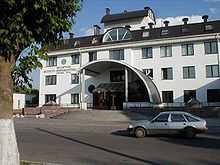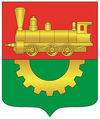Baranovichi
| Baranovichi Баранавічы Барановичи | |||
|---|---|---|---|
|
| |||
| |||
 Baranovichi Location in Belarus | |||
| Coordinates: 53°08′N 26°01′E / 53.133°N 26.017°E | |||
| Country |
| ||
| Voblast | Brest Region | ||
| Raion | Baranavichy Raion | ||
| Mentioned | 1706 | ||
| Founded | 1871 | ||
| Area | |||
| • Total | 53.64 km2 (20.71 sq mi) | ||
| Elevation | 193 m (633 ft) | ||
| Population (2012) | |||
| • Total | 170,286 | ||
| • Density | 3,200/km2 (8,200/sq mi) | ||
| Time zone | EET (UTC+2) | ||
| • Summer (DST) | EEST (UTC+3) | ||
| Postal code | 225320 | ||
| Area code(s) | +375 (0)163 | ||
| Vehicle registration | 1 | ||
| Website |
www | ||



Baranovichi (![]() i/bəˈrɑːnəvɪtʃiː/; Belarusian: Бара́навічы [baˈranavʲitʂɨ], Łacinka: Baranavičy, Baranavichy, Baranavichy; Russian: Бара́новичи, Polish: Baranowicze, Yiddish: באראנאוויטש, Baranovich), is a city in the Brest Region of western Belarus with a population (as of 1995) of 173,000. It is a significant railway junction and home to a state university. It was also the center of the Baranavichy Voblast between 1939-1941 and again between 1944-1954.
i/bəˈrɑːnəvɪtʃiː/; Belarusian: Бара́навічы [baˈranavʲitʂɨ], Łacinka: Baranavičy, Baranavichy, Baranavichy; Russian: Бара́новичи, Polish: Baranowicze, Yiddish: באראנאוויטש, Baranovich), is a city in the Brest Region of western Belarus with a population (as of 1995) of 173,000. It is a significant railway junction and home to a state university. It was also the center of the Baranavichy Voblast between 1939-1941 and again between 1944-1954.
History
Baranovichi (Listeni/bəˈrɑːnəvɪtʃiː/; Belarusian: Бара́навічы [baˈranavʲitʂɨ], Łacinka: Baranavičy, Baranavichy, Baranavichy; Russian: Бара́новичи, Polish: Baranowicze, Yiddish: באראנאוויטש, Baranovich), is a city in the Brest Region of western Belarus with a population (as of 1995) of 173,000. It is a significant railway junction and home to a state university. It was also the center of the Baranavichy Voblast between 1939-1941 and again between 1944-1954.
The village of Baranowicze, as it was originally called, was first mentioned in 1706 as a private property of a Polish family named Rozwadowski. In the late 18th century, in the effect of the Partitions of Poland, the town became part of the Russian Empire. During Russian rule it was part of Navahrudak uzeyd, which was part of firstly in Slonim Governorate between 1795 and 1796, Lithuaina one between 1796 and 1801 and Grodno one between 1801 and 1843 before passing to Minsk one. In the 1870s the locality became an important railway junction, on the crossing of the Warsaw-Moscow and Vilnia-Lviv lines, and was renamed Baranovichi after the Baranovich family.[1] Soon the village started to grow, and by 1883 it became a town of almost 2,000 inhabitants. It was a volost center in Navahrudak uzeyd of Minsk Governorate. By 1897 the population of the town had risen to 4,600 inhabitants (ca. 50% Jews). At the beginning of the First World War it was chosen as the location of the Stavka, which was removed to Mogilev in 8 August 1915 due to German occupation.
Recent history
During the Polish-Soviet war, it was occupied by Poland on 18 March 1919. Soviets retook it on 17 July 1920 but the Polish retook it again on 30 September 1920. On 1 August 1919 it received city rights and became a poviat centre in Nowogródek Voivodship. In 1921 Baranowicze had over 11,000 inhabitants (67% Jews, with the rest being mostly Belarusians, Poles and Russians). Soon the city started to grow and became an important centre of trade and commerce for the area. The city's Orthodox cathedral was built in the Neoclassical style in 1924-31; it was decorated with mosaics that had survived the demolition of the Alexander Nevsky Cathedral, Warsaw. The city was also an important military garrison, with one KOP Cavalry Brigade, 20th Infantry Division and the Nowogródzka Cavalry Brigade stationed there. Because of the fast growth of local industry, in 1938 a local branch of the Polish Radio was opened. In 1939 Baranovichi had almost 30,000 inhabitants and was the biggest and the most important city in the Nowogródek Voivodship.
Soon after the beginning of World War II the control of the city was gained by the Soviet Union. The local Jewish population of 9,000 was joined by approximately 3,000 Jewish refugees from the Polish areas occupied by Germany. After the start of Operation Barbarossa the city was seized by the Wehrmacht on June 25, 1941. In August of the same year a ghetto was created in the city, with more than 12,000 Jews kept in terrible conditions in six buildings at the outskirts. Between March 4 and December 14, 1942, the entire Jewish population of the ghetto was sent to various German concentration camps and killed in gas chambers. Only about 250 survived the war.[2]
The city was seized by the Red Army in July 6, 1944 (Russian and Ukrainan articles of Baranovichi sets liberation date in 8 July 1944). Significant part of the Polish population of the city had been expelled to Siberia and Kazakhstan. Most of remaining Poles were expelled to Poland. After World War II the city became part of the Soviet Union and the Byelorussian SSR and started to be referred to under its Russian name of Baranovichi. In this time an intensive industrialization took place. In 1991 it became part of independent Belarus.
Transport
The city is located on the main east-west highway in Belarus, the M1, which forms a part of European route E30. The first rail line through the city opened around 1870. With additional lines built subsequently, the city developed into an important rail junction. A large military airfield used by the Belarusian Air Force is located just south of the city.
Climate
| Climate data for Baranovichi | |||||||||||||
|---|---|---|---|---|---|---|---|---|---|---|---|---|---|
| Month | Jan | Feb | Mar | Apr | May | Jun | Jul | Aug | Sep | Oct | Nov | Dec | Year |
| Record high °C (°F) | 11.0 (51.8) |
14.7 (58.5) |
20.1 (68.2) |
29.0 (84.2) |
31.5 (88.7) |
32.9 (91.2) |
34.7 (94.5) |
35.7 (96.3) |
31.5 (88.7) |
26.1 (79) |
17.8 (64) |
11.1 (52) |
35.7 (96.3) |
| Average high °C (°F) | −1.7 (28.9) |
−0.8 (30.6) |
4.5 (40.1) |
12.8 (55) |
19.1 (66.4) |
21.6 (70.9) |
23.9 (75) |
23.3 (73.9) |
17.4 (63.3) |
11.0 (51.8) |
3.7 (38.7) |
−0.7 (30.7) |
11.2 (52.2) |
| Average low °C (°F) | −6.5 (20.3) |
−6.6 (20.1) |
−2.8 (27) |
2.9 (37.2) |
8.0 (46.4) |
11.1 (52) |
13.1 (55.6) |
12.3 (54.1) |
8.0 (46.4) |
3.8 (38.8) |
−0.8 (30.6) |
−5.1 (22.8) |
3.1 (37.6) |
| Record low °C (°F) | −33.9 (−29) |
−37.8 (−36) |
−28.9 (−20) |
−10.0 (14) |
−5.0 (23) |
0.9 (33.6) |
3.9 (39) |
−1.1 (30) |
−3.0 (26.6) |
−11.0 (12.2) |
−19.0 (−2.2) |
−29.9 (−21.8) |
−35.4 (−31.7) |
| Average precipitation mm (inches) | 39 (1.54) |
32 (1.26) |
40 (1.57) |
33 (1.3) |
59 (2.32) |
83 (3.27) |
94 (3.7) |
59 (2.32) |
57 (2.24) |
43 (1.69) |
42 (1.65) |
46 (1.81) |
627 (24.69) |
| Source: Pogoda.ru.net[3] | |||||||||||||
Twin cities
- Biała Podlaska (Poland)
- Ferrara (Italy)
- Gdynia (Poland)
- Heinola (Finland)
- Jelgava (Latvia)
- Karlovo (Bulgaria)
- Kineshma (Russia)
- Mytishchi (Russia)
- Novovolynsk (Ukraine)
- Poltava (Ukraine)
- Stockerau (Austria)
- Zhodzina (Belarus)
- Nacka (Sweden)
See also
References
- ↑ E. M. Pospelov, Geograficheskie nazvaniya mira (Moscow, 1998), p. 56.
- ↑ Baranovichi. Holocaust
- ↑ "Weather and Climate-The Climate of Baranovichi" (in Russian). Weather and Climate. Retrieved 7 May 2013.
External links
| Wikimedia Commons has media related to Baranavichy. |
- Baranovichi city portal
- Modern views of Baranovichi
- INTEX-PRESS online - latest news of Baranovichi region
- Public Transport in Baranavichy
- Baranovichi University Photos
Sports-related links:
History-related links:
- Photos on Radzima.org
- Baranowicze Radio Station
- Pre-war photos of Baranovichi
- History of Baranovichi
- Baranavichy in history
- Baranovichi. Synagogues
- British 1:25,000 map from 1943
| ||||||||||||


